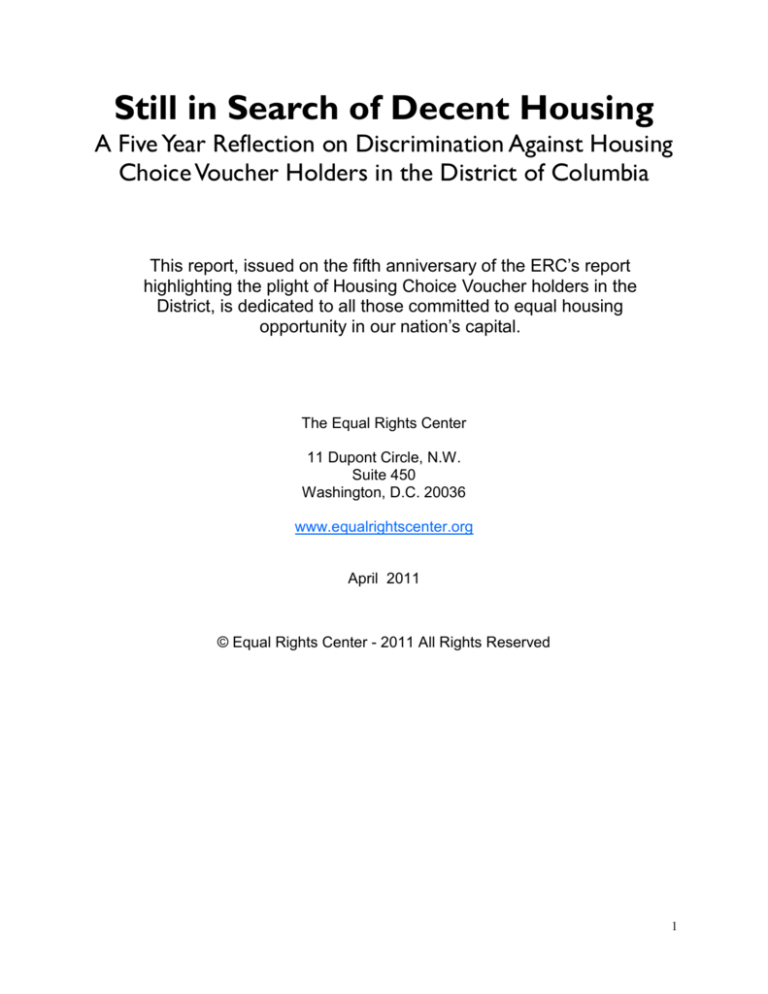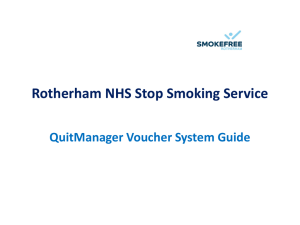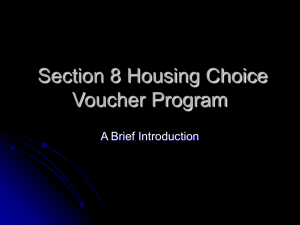
Still in Search of Decent Housing
A Five Year Reflection on Discrimination Against Housing
Choice Voucher Holders in the District of Columbia
This report, issued on the fifth anniversary of the ERC’s report
highlighting the plight of Housing Choice Voucher holders in the
District, is dedicated to all those committed to equal housing
opportunity in our nation’s capital.
The Equal Rights Center
11 Dupont Circle, N.W.
Suite 450
Washington, D.C. 20036
www.equalrightscenter.org
April 2011
© Equal Rights Center - 2011 All Rights Reserved
1
Table of Contents
About the Author
3
Executive Summary
3
The Washington D.C. Housing Market
5
The Housing Choice Voucher Program
6
Protections Against Source of Income
7
Discrimination in Washington D.C.
Project Overview
8
Project Methodology
9
Test Results
10
Conclusion
11
2
About the Author
The Equal Rights Center
Originally formed in 1983, the Equal Rights Center (the “ERC”) is a national non-profit
civil rights organization dedicated to promoting equal opportunity in housing, employment, public
accommodations and government services. With more than 2,200 members in 42 states and
the District of Columbia, the ERC uses a comprehensive approach to advance civil rights,
including counseling, education and outreach, research and investigation, advocacy and
enforcement. Working in the District and across the United States for nearly 30 years, the ERC
has developed an expertise in civil rights testing that has been recognized by federal and state
governments, civil rights organizations, and the courts.
Executive Summary
In addition to federal civil rights protections, residents of the District of Columbia benefit
from the D.C. Human Rights Act (the “DCHRA”), one of the most expansive human rights acts
in the country.
Building upon the seven federally protected classes (race, color, religion,
national origin, gender, familial status and disability), the DCHRA offers protections to twelve
additional groups including “source of income.” Under the DCHRA, the District’s landlords and
property managers are prohibited from discriminating against an individual because he or she
wants to pay rent with various types of funds, including government subsidies such as Housing
Choice (formerly Section 8) Vouchers (“HCV”).
Currently assisting more than two million American families, the Housing Choice
Voucher Program (“HCVP”) is the largest federal housing subsidy program. The HCVP allows
qualifying families to obtain market-rate housing in locations of their choice. Because HCV’s are
“portable,” they promote diversity with respect to race, ethnicity, and socioeconomic status, and
3
allow families to move into neighborhoods close to jobs, better schools, and necessary services.
More than five years ago, the ERC began conducting a groundbreaking testing
investigation consisting of more than 100 tests of 75 housing providers to determine compliance
with the source of income protections of the DCHRA, and in 2005 published, In Search of
Decent Housing in the D.C. Metropolitan Area: The Affordable Housing Crisis for Section 8
Voucher Holders. This report documented a staggering 61% rate of discrimination against
voucher holders—including a 26% rate of outright refusals of their vouchers and a 35%
rate of encountering limitations that would bar most voucher holders from renting
available units.1
In the following five years, through a program of education, outreach and
enforcement, the ERC reached more than 20 agreements with D.C. landlords and property
managers to open more than 15,000 apartments to HCV holders.
In 2010, the ERC undertook a second testing investigation of District housing providers
to determine if compliance with source of income protections had improved.
The ERC
conducted 91 tests consisting of 42 management companies and 38 landlords in all four
quadrants of the District. Although compliance with DCHRA source of income protections
has improved dramatically, the recent testing found that 45% of people seeking to rent
housing with an HCV continue to face discrimination—with 15% being met by outright
refusals to accept vouchers, and another 30% faced with some kind of discriminatory
barrier to the use of their vouchers.
This revisiting of source of income discrimination in the nation’s capital demonstrates
that the plight of HCV holders has, in fact, improved over the last five years. However, much
remains to be done. When nearly every other attempt to use a voucher (45%) is met with some
type of discriminatory barrier, our fair housing agencies—both governmental and private—are
not protecting this vulnerable population. We must do more.
4
The Washington D.C. Housing Market
Between 2000 and 2010, the population of the District of Columbia grew by 5.2 percent
to 601,723 people.2 This rapid population increase, combined with the real estate housing crisis,
a tight economy, and a generally high cost of living in the District, has created a crisis of
insufficient “affordable” housing. Affordable housing is most often defined as housing that does
not exceed more than 30 percent of total household income. In the District, it is reported that
approximately 40 percent of D.C. households spend more than 30 percent of their income on
housing costs, and approximately 20 percent of D.C. households experience “severe” housing
affordability problems—spending half or more of their income on housing.3
The average sales price of a single family home in the Washington, D.C. metropolitan area as of
December, 2010 was $329,500.4 Due to these high costs, the only alternative for most lowincome families is rental housing.
The supply of affordable rental housing in the District,
however, is also limited. Since 2000, Washington, D.C. has experienced the 5th highest growth
in rent, outpacing cities such as Los Angeles and New York, 4 resulting in raising the average fair
market rent for a one bedroom apartment to $1,318.6 This increase in rent is compounded by a
shrinking stock of rental housing in the District. Since 2000, the general rental market has
shrunk by 19 percent, and more acutely, there has been a drop of almost 30 percent in the lowcost rental market.7
In addition to these rising costs, poverty continues to rise.
The D.C. Fiscal Policy
Institute concluded that, in 2010, the District experienced its largest single-year increase in
poverty since 1995, estimating that the District has 106,500 residents —one sixth of the city’s
residents—living at or below the poverty line ($21,800 for a family of four in 2009). 8 This is
11,000 more individuals living in poverty than in the prior year alone, an increase of
almost 12 percent.
Nowhere is this intersection of poverty and the high cost of decent housing more critical
and more painful than among HCV holders. By way of comparison, the median income for a
family of four in the District was reported in 2008 to be more than $94,000,9 yet, according to the
5
D.C. Housing Authority in 2008, nearly all the applicants for housing assistance, including the
Housing Choice Voucher Program, had incomes of less than $30,000 for a family of four.
10
The Housing Choice Voucher Program
One valuable tool used to ameliorate the critical shortage of affordable housing is the
Housing Choice Voucher Program (HCVP).11 Initiated in 1974, the HCVP is a federal program
for assisting very low-income families, the elderly, and people with disabilities to afford decent,
safe, and sanitary housing in the private market.12 The HCVP is administered by the U.S.
Department of Housing and Urban Development (HUD), and is the largest federal housing
subsidy program, assisting more than 2 million American families each year. 13 Without these
vouchers, many families and individuals would be forced to live in unsafe housing or pay more
than half of their income for rent.14
Because HCVs are “portable,” i.e., they are not tied to designated housing properties or units,
the HCVP helps families move from substandard housing and promotes diversity with respect
to race, ethnicity, and socioeconomic status by permitting families to gain access to a wider
range of neighborhoods than they could have reached without the voucher.15
Under the HCVP, low-income households receive a voucher through their local public
housing agency. A voucher represents a direct payment from the housing authority to the
landlord for all or a portion of monthly rent. HCV’s may be used to rent any apartment,
single-family home, or townhouse provided: (1) the physical condition of the housing meets
federally-established quality standards, and (2) the total monthly rent is no more than the rental
payment standard established for that area by the local housing authority. HCV holders are
required to contribute 30 percent of their own monthly income toward rent, with the remainder of
the monthly rent paid by the local public housing agency directly to the landlord. Local public
housing agencies may also provide participating families with additional financial assistance to
help cover monthly utility expenses.
In 2010, the maximum HCVP payment standards in the District reflected the rapidly
6
rising cost of housing in the nation’s capital. Although factors such as family size and disability
affect the size of units for which a voucher holder is eligible, Chart 1 summarizes the increase in
maximum rent qualifying for the HCVP in the District in 2010 as compared to 2005:
Unit Size
2005 Payment
Standard
2010 Payment Standard
Efficiency
Up to $915
Up to $1272
1 bedroom
Up to $1045
Up to $1450
2 bedroom
Up to $1187
Up to $1643
3 bedroom
Up to $1537
Up to $2120
Chart 1
Though HCV holders are not restricted to where they may seek affordable housing
within their jurisdiction, the HCV will expire if not used within a limited period of time.16 If unable
to use an HCV within the allotted time, the voucher expires and the family goes to the end of the
waiting list to obtain a new voucher.17
In 2011, information provided by the D.C. Housing
Authority confirmed that, in the District, there were 10,596 families being served by the HCVP
and 34,717 on the waitlist.18
Protections Against Source of Income Discrimination
in Washington D.C.
Discrimination against HCV holders can have a profoundly adverse effect on the housing
choices that are available to home-seekers, and can perpetuate patterns of racial, ethnic, and
economic segregation.19
Far too often, a housing voucher is all that stands between a family
and homelessness. While not protected at the federal level, discrimination against a person
participating in the HCVP is outlawed by civil and human rights laws in more than 13 states and
in 30 local jurisdictions, including the District of Columbia and several jurisdictions in Maryland. 20
7
In the District, housing discrimination based on a person’s “source of income,” including HCVs,
has been prohibited under the D.C. Human Rights Act, D.C. Code 2-1401.02 (29), since 1977.21
Despite these protections, some landlords and property managers continue to refuse to
rent to HCV holders, because of a lack of awareness of their responsibilities under the law,
stereotypes about the households who participate in public assistance programs, or as a proxy
for discrimination based on other protected demographics such as race or familial status.22
According to HUD, nationally, 62% of voucher holders are designated as racial minorities (42%
of voucher holders identified as Black, non-Hispanic), and 48% of voucher holder households
are female-headed with children.23
In D.C., these demographics are even more pronounced
with 77.9% of voucher holders designated as racial minorities.24
Project Overview
In 2005, the ERC conducted a large scale testing investigation of 100 D.C. rental
properties to determine the existence and extent of discrimination against voucher holders when
seeking rental housing.
Trained ERC testers, posing as HCV holders, inquired about the
availability of housing and gathered information about the policies and practices of housing
providers with respect to the acceptance of HCV’s. The 2005 ERC report, In Search of Decent
Housing in the D.C. Metropolitan Area: The Affordable Housing Crisis for Section 8 Voucher
Holders, detailed its findings—a 61% rate of discrimination against HCV holders.25
The
ERC followed this study with a similar study in the D.C. suburbs in Montgomery County, MD,
finding a 15% rate of discrimination against HCV holders.
26
In the five years since release of its first report documenting this discrimination, the ERC
has engaged in a concerted campaign to remedy the effects of past source of income
discrimination and to prevent future discrimination.
This campaign utilized a multifaceted
approach, including:
Directly collaborating with the D.C. Office of Human Rights in both education and
8
outreach efforts and administrative enforcement efforts;
Conducting scores of events reaching out to HCV holders to teach them about the
protections available to them;
Developing fair housing training courses for landlords and property managers to teach
them their responsibilities under the civil rights laws;
Commencing more than 20 enforcement actions to require individual landlords and
property managers to comply with the DCHRA;
Publicizing rental units available to voucher holders through a network of affordable
housing agencies; and
Negotiating agreements with no less than 20 landlords to make more than 15,000
apartment units available to voucher holders.
The ERC’s 2010 testing investigation, consistent in methodology and scope to its 2005
investigation, tested 91 rental properties, consisting of 42 management companies and 38
landlords in all four quadrants of Washington D.C. As in 2005, the 2010 study defined
“discriminatory treatment” as: (1) the refusal to accept housing vouchers, (2) limiting the use of
vouchers, (3) providing different terms and conditions for voucher holders than for non-voucher
holder applicants, or (4) imposing requirements that would effectively bar most voucher holders
looking for rental housing.
Project Methodology
Using the payment standards set by the D.C. Housing Authority, the ERC compiled a list
of testable properties comprised of one, two and three bedroom apartments in the District. Over
the course of the study, ERC staff periodically re-evaluated and updated this list to ensure
geographic diversity and to protect against repeat testing of housing providers. As home
seekers’ reliance on the Internet as a resource for housing listings has increased, the ERC’s
search for testable properties placed an emphasis on online advertising, particularly on the
website “Craigslist.”
9
After a property was identified and its rental rates confirmed to be within the payment standards,
an “advance call” was placed to ensure that the property (or units within the property) was
available and priced as advertised. In each test, trained ERC testers were provided with a
detailed profile including specific personal and financial characteristics—income, household
size, and rental history—designed to realistically reflect a HCV holder in Washington, D.C.
Each test assignment also contained a list of questions for the tester to ask the housing provider
in order for the ERC to determine the treatment of potential HCV renters.
Test Results
The ERC’s 2010 testing investigation revealed that 45% of the time (41 out of 91 tests)
HCV holders were subjected to at least one form of discriminatory treatment—outright
refusal to accept vouchers, limiting the use of the voucher, imposing different terms or
conditions for HCV holders, or imposing limitations that would effectively bar HCV holders from
obtaining the housing. While the most common notion of discrimination is that of an outright
refusal to accept an HCV, more subtle forms of discrimination, such as differential treatment and
unreturned phone calls about housing availability, also create very real barriers to equal housing
opportunity. In its 2010 testing, the ERC documented:
Outright Refusals:
In 15% of the tests (14 out of 91), landlords or property
managers refused outright to accept vouchers. In one blatant example, the housing
provider immediately hung up the phone when the tester asked if he or she could use a
HCV to pay rent. In another instance, the ERC tester posing as an HCV holder was told
that the landlord “did not believe in vouchers.”
Another housing provider refused to
accept an HCV because he was unwilling to “make any changes to his leasing process”
that would give HCV holders the opportunity to rent the property.
Differing Terms and Conditions:
In 9% of the tests (8 out of 91), the ERC’s
10
investigation showed differential (and adverse) treatment of voucher holders. In
two instances, testers were told, although vouchers were accepted at the building, they
were only accepted for unit sizes other than those currently advertised as available. In
three instances, testers were told, contrary to voucher guidelines, the voucher must
cover the entire rental amount. In one instance, a tester was told the apartment building
had reached its “quota” of voucher holders, and would not accept any more. Finally, one
property manager repeatedly emphasized the “thorough” review he would do with the
tester’s previous landlord, citing his belief that voucher holders have a propensity to “tear
up the property.”
Income Limits: In 21% of the tests (19 of 91) the tester was informed of an income
or credit requirement which would effectively bar any and all voucher holders
from renting the advertised unit. In one extreme case, one landlord renting a one
bedroom apartment for $1,300 a month (well within the HCV rental payment standard of
$1,450 per month) imposed a $64,000 income requirement on potential tenants—in
effect, creating an absolute bar to all HCV holders (whose average income is only
$30,000).
Conclusion
Housing Choice Voucher holders represent a particularly vulnerable community. Living
at the intersection of poverty, race, ethnicity, disability, and ever-rising housing costs, in many
instances being able to actually use a voucher, free from discrimination, is all that stands
between a family and homelessness.
In the last five years, the ERC has worked to remediate source of income discrimination
in the nation’s capital, with a successful reduction in this type of discrimination. However, much
more remains to be done. Equal housing opportunity can only be achieved through the
continued vigilance of housing and civil rights activists and government authorities. With this
11
report, the ERC hopes to demonstrate the persistence of source of income discrimination, and
to inspire more advocates to work with the ERC in order to completely eradicate this form of
discrimination from our nation’s capital.
1This
report is available at http://www.equalrightscenter.org/site/DocServer/Report.pdf?docID=154
U.S. Census Bureau, “2010 Data: Population growth.” Available at
http://2010.census.gov/2010census/data/
3 D.C. Fiscal Policy Institute, “Nowhere to Go: As D.C. Housing Costs Rise, Residents Are Left with Fewer
Affordable Housing Options,” (February 2010). Available at: http://D.C.fpi.org/nowhere-to-go-as-D.C.housing-costs-rise-residents-are-left-with-fewer-affordable-housing-options
4 See National Association of Realtors, “Existing Home Sales for December 2010.” Available at
http://www.realtor.org/research/research/ehsdata
5 D.C. Fiscal Policy Institute, “Nowhere to Go: As D.C. Housing Costs Rise, Residents Are Left with Fewer
Affordable Housing Options,” (February 2010). Available at: http://D.C.fpi.org/nowhere-to-go-as-D.C.housing-costs-rise-residents-are-left-with-fewer-affordable-housing-options
6See National Low Income Housing Coalition, “Out of Reach 2010.” Available at
http://www.nlihc.org/oor/oor2010/
7See D.C. Fiscal Policy Institute, “Nowhere to Go: As D.C. Housing Costs Rise, Residents Are Left with
Fewer Affordable Housing Options,” (February 2010). Available at http://D.C.fpi.org/nowhere-to-go-asD.C.-housing-costs-rise-residents-are-left-with-fewer-affordable-housing-options
8 Id.
9See Yolanda, Woodlee, Washington Post, “Agency is Updating Housing Aid Wait List.” Available at
http://www.washingtonpost.com/wp-dyn/content/article/2008/01/15/AR2008011503507_pf.html
10 Id.
11The regulations that govern this program may be found at 24 CFR Part 982.
12See U.S. Department of Housing and Urban Development, Housing Choice Voucher Fact Sheet.
Available at http://www.hud.gov/offices/pih/programs/hcv/about/fact_sheet.cfm
13 U.S. Department of Housing and Urban Development’s Resident Characteristics Report, at
https://pic.hud.gov, accessed September 29, 2008, shows 2,208,802 voucher units under contract
between HUD and program administrators.
14 U.S. Department of Housing and Urban Development, Office of Policy Development and Research,
“Affordable Housing Needs 2005: Report to Congress,” (2007).
15Martha M. Galvez, “What Do We Know About Housing Choice Voucher Program Location Outcomes?”
(August 2010). Available at http://www.urban.org/UploadedPDF/412218-housing-choice-voucher.pdf
See also: Austin Turner, Margery. Popkin, Susan J. Rawlings, Lynette, “Public Housing and the Legacy of
Segregation” at p. 79, ch. 3 – Moving to Neighborhoods of Opportunity: Overcoming Segregation and
Discrimination in Today’s Housing Markets.
16 Voucher holders in the District have up to 180 days to use vouchers (an initial 60 day period and up to
120 days in extensions). Data provided by: D.C. Housing Authority’s Dena Michaelson, Director Public
Affairs and Communications, April 2011.
17 Baran, Madeleine, The New Standard, “Economic Hardship Causing Drastic Increase in U.S.
Homelessness.” (September 12, 2004). Available at
http://newstandardnews.net/content/index.cfm/items/978
18 While the D.C. Housing Authority advises that it does not keep information on the average length of
time an individual remains on its waitlist before obtaining a voucher, it has been reported that tenants in
our nation’s capital can wait an average more than six years to receive a voucher. Data Provided by:
D.C. Housing Authority’s Dena Michaelson, Director Public Affairs and Communications.
19 See Poverty & Race Research Action Council, “Keeping the Promise: Preserving and Enhancing
Housing Mobility in the Section 8 Housing Choice Voucher Program.” Available at
http://www.prrac.org/pdf/AppendixB-Feb2010.pdf
20Center for Policy Alternatives, “Source of Income Discrimination.” Available at
http://www.cfpa.org/issues/issue.cfm/issue/SourceofIncomeDiscrimination.xml.
2 See
12
21Even
in jurisdictions without source of income protections, landlords participating in the federal LowIncome Housing Tax Credit Program, which provides tax incentives to investors who develop low-income
housing, are prohibited from discriminating against potential tenants because they have HCV’s. See,
e.g., 26 CFR § 1.42-5
22 Thabault, Isabelle M. and Platts-Mills, Eliza T., Poverty & Race Research Action Council,
“Discrimination Against Participants in the Housing Choice Voucher Program: An Enforcement Strategy.”
Available at
http://www.prrac.org/full_text.php?text_id=1071&item_id=9757&newsletter_id=85&header=Economic+%2
F+Community+Development
23See Department of Housing and Urban Development, “A Picture of Subsidized Households-2008.”
Available at http://www.huduser.org/portal/picture2008/index.html
24Housing Choice Voucher Holders by Race/Ethnicity, 2000. Available at http://diversitydataarchive.org/Data/Rankings/Show.aspx?ind=165
25The full text of this report is available at,
http://www.equalrightscenter.org/site/DocServer/Report.pdf?docID=154
26See Equal Rights Center, “A Step Away From Homelessness—Housing Choice Voucher Holders
Denied Housing in Montgomery County, MD” (2008). Available at
http://www.equalrightscenter.org/site/DocServer/Montgomery_County_Section_8.pdf?docID=150
13








